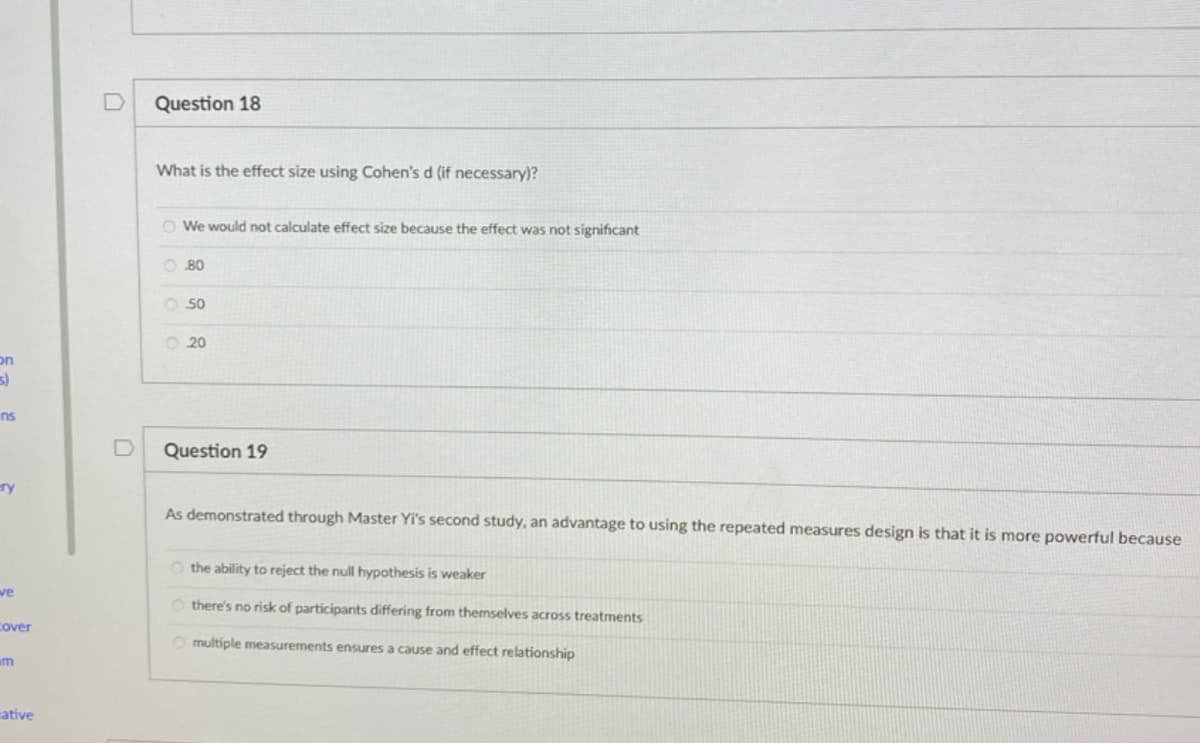Now assume that Master Yi actually completed a repeated measures design in which he had the same two treatment conditions sted in the above example, but tested this on a single sample of participants, in which they got the control condition first, simply submerging their hands in the cold water for as long as they can stand, and the meditative breathing condition second. in which Master Y taught the participants meditative breathing exercises and had them use this during the cold presser task for the second measurement. The raw data for this study is exactly the same as in the previous example, except this time Yi can use a related samples t test to see if there are dfferences in pain tolerance between the two condicions. The results demonstrated that, on average, participants showed increased pain tolerance after they had learned and used meditative breathing as indicated by the mean of the difference scores Mo-84, SSp-1004, -10 Using a related samples t test approach, at a05 two tailed, complete the questions below
Now assume that Master Yi actually completed a repeated measures design in which he had the same two treatment conditions sted in the above example, but tested this on a single sample of participants, in which they got the control condition first, simply submerging their hands in the cold water for as long as they can stand, and the meditative breathing condition second. in which Master Y taught the participants meditative breathing exercises and had them use this during the cold presser task for the second measurement. The raw data for this study is exactly the same as in the previous example, except this time Yi can use a related samples t test to see if there are dfferences in pain tolerance between the two condicions. The results demonstrated that, on average, participants showed increased pain tolerance after they had learned and used meditative breathing as indicated by the mean of the difference scores Mo-84, SSp-1004, -10 Using a related samples t test approach, at a05 two tailed, complete the questions below
Holt Mcdougal Larson Pre-algebra: Student Edition 2012
1st Edition
ISBN:9780547587776
Author:HOLT MCDOUGAL
Publisher:HOLT MCDOUGAL
Chapter11: Data Analysis And Probability
Section: Chapter Questions
Problem 8CR
Related questions
Question
in photos

Transcribed Image Text:Now assume that Master Yi actually completed a repeated measures design in which he had the same two treatment conditions listed in the above example, but
tested this on a single sample of participants, in which they got the control condition first, simply submerging their hands in the cold water for as long as they can
stand, and the meditative breathing condition second, in which Master Yi taught the participants meditative breathing exercises and had them use this during the
cold presser task for the second measurement. The raw data for this study is exactly the same as in the previous example, except this time Yi can use a related
samples t test to see if there are differences in pain tolerance between the two conditions. The results demonstrated that, on average, participants showed increased
pain tolerance after they had learned and used meditative breathing, as indicated by the mean of the difference scores:
Mp -84, SSp - 1004, n- 10
Using a related samples t test approach, at a-.05 two tailed, complete the questions below:

Transcribed Image Text:Question 18
What is the effect size using Cohen's d (if necessary)?
O We would not calculate effect size because the effect was not significant
O 80
O 50
O 20
on
ns
Question 19
ry
As demonstrated through Master Yi's second study, an advantage to using the repeated measures design is that it is more powerful because
O the ability to reject the null hypothesis is weaker
ve
O there's no risk of participants differing from themselves across treatments
Cover
O multiple measurements ensures a cause and effect relationship
um
ative
Expert Solution
This question has been solved!
Explore an expertly crafted, step-by-step solution for a thorough understanding of key concepts.
This is a popular solution!
Trending now
This is a popular solution!
Step by step
Solved in 2 steps with 2 images

Recommended textbooks for you

Holt Mcdougal Larson Pre-algebra: Student Edition…
Algebra
ISBN:
9780547587776
Author:
HOLT MCDOUGAL
Publisher:
HOLT MCDOUGAL

Holt Mcdougal Larson Pre-algebra: Student Edition…
Algebra
ISBN:
9780547587776
Author:
HOLT MCDOUGAL
Publisher:
HOLT MCDOUGAL